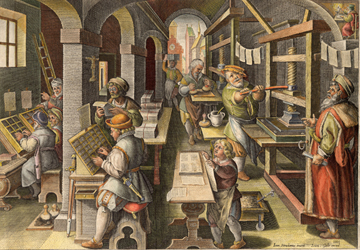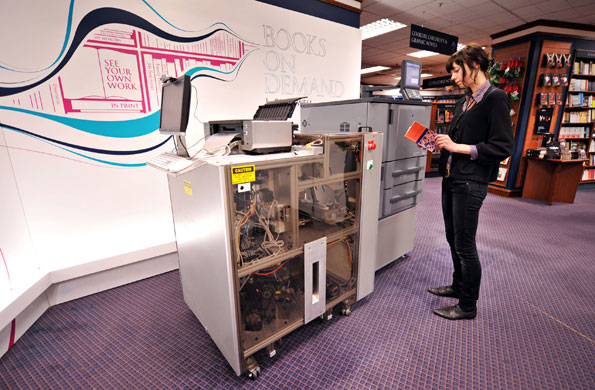
This is something that’s come up a few times in different contexts lately, and I thought I’d tackle the subject to clear up some misconceptions.
Printing.
Yes, it still happens. Actual, physical, paper books are still constructed out of dead trees, ink, and glue. They still get shipped out and put on bookshelves, then bought and brought home and read and handled and put on different bookshelves.
In fact, this is still where the majority of the publishing business takes place, and where it makes its money. Digital is surging, but print books are still where it’s at.

Which is not to say that the print model makes any sense. At a traditional, large publishing firm, print runs are a sort of intricate voodoo, in which strange and esoteric calculations and predictions are made, resulting in a figure. That figure is the number of books that is ordered. Where it comes from has something to do with the current market for that genre, pre-orders placed by buyers from large chains like Barnes & Noble, and how confident the publisher is it has a hit on its hands.
The number is typically in the tens of thousands.
So that is the number of books printed, warehoused, shipped, and distributed.
Thing is, many of those books never sell. They are made, and they go out to stores, and then they don’t sell. So they’re stripped – which is to say, their covers are ripped off – and they’re sent back to be pulped – which is to say, destroyed, and hopefully used to make new books. Another gamble of a run.
This is, shall we say, dreadfully inefficient. It’s harmful to the environment (So many trees needlessly sacrificed! So many tons of carbon emitted hauling the things back and forth!) and it’s really not great for either authors or publishers. Y’see, there’s this thing called “reserve against returns,” wherein a publisher sets aside a certain amount of an author’s sales against the books that can’t be sold, or that are returned. That’s money you won’t see unless/until it’s reconciled against ACTUAL returns. Kinda sucky, right? Kinda sucks for the publisher, too, taking a gamble on how many books to print and hoping they get it right – because producing too many means you paid a whole lot of money for books that now have to be returned and pulped, and producing too few means either not fulfilling orders or having to do a second print run, which means more guesswork on those voodoo numbers.
And this, my friends, is where short-run printing comes in.

You see, there is this magical thing that is called digital printing. Unlike offset, which is what you use to get those tens-of-thousands print runs done, digital printing uses a system that can produce as little as a single book at a time. And, thanks to advances in printing technology, it can do it at a quality that’s as good as offset. Seriously, I’m a print geek, people, and well-done digital is nearly impossible to tell from offset at a glance. (Note the “well-done” there – lousy digital printing is still lousy. Then again, cheap offset can be lousy. It’s all about the quality of the printer you’re running through.)
Anyway.
Digital printing.
It’s awesome.
It’s also what the future is going to be.
As we move towards a more digital system of publishing, and as more people adopt eBooks, you’re going to see smaller and smaller print runs. Print will still be around, but you’re going to see fewer and fewer massive print runs, for all the reasons I outlined above – they’re just inefficient. And as prices on digital printing drop (right now, it’s about 5x more expensive to do short-run digital than to do offset; three years ago, it was 10x more expensive. Prices are still dropping.) we will start seeing more and more publishers – including large traditional publishers – moving to shorter print runs using digital production techniques.
 This is the future, folks. Espresso Book Machines in bookstores, able to crank out exactly the book you want right in front of you.
This is the future, folks. Espresso Book Machines in bookstores, able to crank out exactly the book you want right in front of you.
Until then, we have short-run digital. This is not Print-on-Demand (POD), but it’s darn close. In fact, many suppliers/printers use the same technology and printers for both; the difference is in the warehousing, distribution, and fulfillment.
What are the advantages here? Well, not cost, as I mentioned – it costs about 5 times more per copy to physically produce a short-run digital book as opposed to a full-run offset book. However, you make up a lot of that in efficiency, especially if you’re a small operation. You have fewer books to house, and you have less worry about returns – if you have returns at all. Because, you see, you’re producing no more than about 5,000 books at any given time, and usually much less than that. So you fulfill orders as they happen, not based on guesstimates and voodoo math. So there’s little to no waste, and no schlepping books around the country only to have them be returned to be shredded.
Smart, don’t you think?
This is what Candlemark & Gleam does. We did a lot of shopping around for printers and printing solutions when we went paperback, and we did a lot of thinking about business models and how to make the economics of the thing work…and about how to make the environmental aspects work as well.
The most efficient solution for a small publisher is short-run digital. Period. If you’re a huge corporation that gets pre-orders for 10,000 copies of whatever you proclaim will be the next bestseller, you can afford to risk a hundred thousand dollars on a large offset print run, to get your per-book production costs down. If you’re a small press that aims to sell around 5,000 copies of a book total, it just doesn’t make any sense.
Thus, digital short run. We’re incredibly pleased with our print company, which happens to do all types of printing – POD (aka, single-copy orders), digital short-run, and offset. We know for a fact that their print services are used by a number of companies known for their high-quality books, and we have compared print samples of our books to offset books – depending on who the offset company is, our books are actually higher quality, with better reproduction, nicer paper, and far nicer cover stock. A number of large publishing firms use our supplier for their backlist, too. Ever hear of Macmillan? Yeah.
Plus, our books are printed in the US, rather than at a cheap Chinese printer. It’s a plus.
For distribution, we’re able to work with printers in the UK and Australia to get books printed locally, making it more affordable to get books to those markets.
Short-run printing isn’t “cheap” anymore – it’s not some guy in the back of a Kinkos hustling out Xeroxed copies and pasting them into a cover. You rarely have any more mixed-up pages or other printer’s errors than you do in an offset run. And you have the advantage of less waste and less environmental impact.
See? Makes sense.
Hopefully, people will learn that POD and digital short run don’t mean “cheap Kinkos printing” and will accept that this is a reasonable, intelligent business model, particularly for small startup presses (like C&G). And hopefully they’ll embrace the fact that this means less waste and less inefficiency in the system, which is good for everyone.
As we move into the era of digital books, this is what we’re going to be seeing. There will be eBooks for mass consumption on the run, right when and where you want it, delivered to your device. There will be POD and digital short run books (and, hopefully, lots of Espresso machines with lots of titles available on demand) for those people who want paper books in their lives. And there will be lovely, intricate collector’s editions (hardback or handbound) for people who truly value the art of the book.
That’s what we envision. That’s what we’re working towards. That’s what we’re doing.

*stands up and applauds*
Thank you!
Way to go, Kate!!!
You know me. I mouth off about this stuff.
Glad you liked!
Thank you for this! I’ve been wondering about publishing, printing, digital vs traditional, etc. etc. in one corner of my brain, but had no idea how to find out more info. Now I have it!
You’re most welcome! If you have any specific questions, I’d be glad to give answering them a shot…
Coming from someone that’s mucked around in illustration, design, and printing, I definitely agree that short run and POD is the now as well as the future. I’m still mildly bemused about the number of people that persist in being snobs about it—the assumption that short run and POD = poor quality tends to endure, I suspect, because the only time they notice a POD is when it happens to be poor quality.
I’m glad this post happened, because now I can just point people at it instead of waving my hands around and making inarticulate noises at their biases. 😉
Seriously, I defy anyone to tell a /quality/ POD book from most offset printing these days, especially if you remove the barcoded page at the back of the book block. I think you’re exactly right when you say that the only time people notice is when it’s BADLY done, which means that it reinforces the idea that POD or even digital short-run is second-rate. Which is quite the pity…